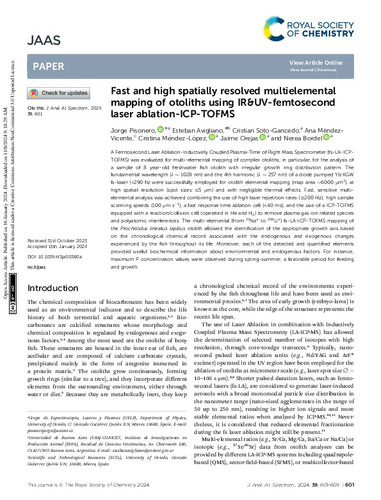Fast and high spatially resolved multielemental mapping of otoliths using ir&uv-femtosecond laser ablation-icp-tofms
Fecha de publicación:
Versión del editor:
Citación:
Descripción física:
Resumen:
A Femtosecond Laser Ablation-Inductively Coupled Plasma-Time of Flight Mass Spectrometer (fs-LA-ICPTOFMS) was evaluated for multi-elemental mapping of complex otoliths; in particular, for the analysis of a sample of 8 year-old freshwater fish otolith with irregular growth ring distribution pattern. The fundamental wavelength (l ∼ 1028 nm) and the 4th harmonic (l ∼ 257 nm) of a diode pumped Yb:KGW fs-laser (<290 fs) were successfully employed for otolith elemental mapping (map area ∼6000 mm2 ), at high spatial resolution (spot sizes #5 mm) and with negligible thermal effects. Fast, sensitive multielemental analysis was achieved combining the use of high laser repetition rates ($200 Hz), high sample scanning speeds (100 mm s−1 ), a fast response time ablation cell (<40 ms), and the use of a ICP-TOFMS equipped with a reaction/collision cell (operated in He and H2) to remove plasma gas ion related species and polyatomic interferences. The multi-elemental (from 23Na+ to 238U+) fs-LA-ICP-TOFMS mapping of the Prochilodus lineatus lapillus otolith allowed the identification of the appropriate growth axis based on the chronological chemical record associated with the endogenous and exogenous changes experienced by the fish throughout its life. Moreover, each of the detected and quantified elements provided useful biochemical information about environmental and endogenous factors. For instance, maximum P concentration values were observed during spring-summer, a favorable period for feeding and growth.
A Femtosecond Laser Ablation-Inductively Coupled Plasma-Time of Flight Mass Spectrometer (fs-LA-ICPTOFMS) was evaluated for multi-elemental mapping of complex otoliths; in particular, for the analysis of a sample of 8 year-old freshwater fish otolith with irregular growth ring distribution pattern. The fundamental wavelength (l ∼ 1028 nm) and the 4th harmonic (l ∼ 257 nm) of a diode pumped Yb:KGW fs-laser (<290 fs) were successfully employed for otolith elemental mapping (map area ∼6000 mm2 ), at high spatial resolution (spot sizes #5 mm) and with negligible thermal effects. Fast, sensitive multielemental analysis was achieved combining the use of high laser repetition rates ($200 Hz), high sample scanning speeds (100 mm s−1 ), a fast response time ablation cell (<40 ms), and the use of a ICP-TOFMS equipped with a reaction/collision cell (operated in He and H2) to remove plasma gas ion related species and polyatomic interferences. The multi-elemental (from 23Na+ to 238U+) fs-LA-ICP-TOFMS mapping of the Prochilodus lineatus lapillus otolith allowed the identification of the appropriate growth axis based on the chronological chemical record associated with the endogenous and exogenous changes experienced by the fish throughout its life. Moreover, each of the detected and quantified elements provided useful biochemical information about environmental and endogenous factors. For instance, maximum P concentration values were observed during spring-summer, a favorable period for feeding and growth.
ISSN:
DOI:
Notas Locales:
OA ATUO24
Patrocinado por:
Spanish Ministerio de Ciencia e Innovacion [MCI-21-PID2020-113951GB-I00]; CONICET [PIBAA 2872021010]; Nu Instruments; ESI; Principality of Asturias, Spain [BP20-059]
Colecciones
- Artículos [37549]
- Física [2013]
- Investigaciones y Documentos OpenAIRE [8420]
Ficheros en el ítem





